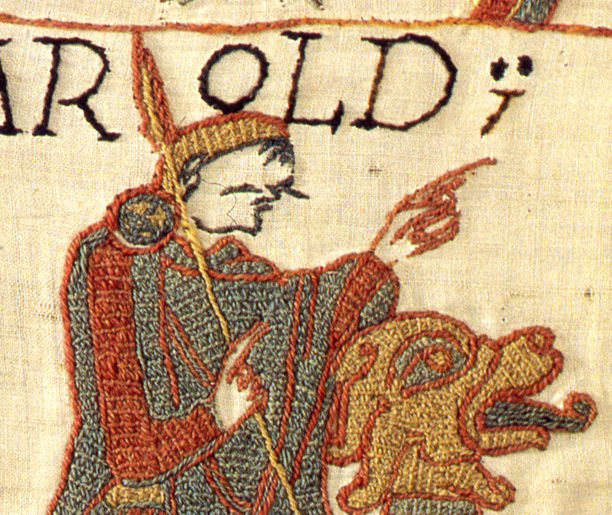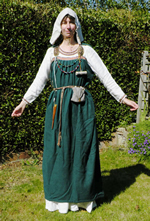Eleventh century women did care about their appearance. Of course they did! Cosmetics were not as horrific as those used in Tudor times, such as lead to whiten the complexion or belladonna to brighten the eyes. These earlier treatments were generally less sinister and not quite so harmful. We know about cosmetics from The Trotula which was a compendium of women's medicine in medieval Europe. The mysterious Trotula was said to be the first female professor of medicine in eleventh century Salerno, south of Naples. Salerno was, indeed, the leading centre of medicine learning in medieval Europe for many centuries.
In this wonderful book there is a section entitled 'On Women's Cosmetics'. The suggestions here range from depilatory treatments to hair treatments and face adornment. There are also recorded treatments for whitening the teeth and for lip care.
Here are a few of my favourites, ideas which I have consulted for my second novel in a trilogy about The Women of Hastings that is scheduled to follow from Edith Swan-Neck's story in The Handfasted Wife.
Look at the bottom of this post for a free I tunes copy of this novel.
The Depilatory
Take quicklime and orpiment (a yellow sulphide mineral). Place these in a small linen sack and let them boil until they are cooked. If the depilatory be too thick, put fresh water in it to thin it. Take care it is not cooked too much and does not stay on the skin too long. It causes intense heat. And note that the dried powder of this is good for abrading bad flesh and for making hair grow again on the heads of people with tinea (ringworm infection). But first the affected place must be anointed with oil or honey. Then the powder is sprinkled on.
A Cure for Blemishes
Take the juice of squirting cucumber and almond milk; with these placed in a vessel, gently mix in quicklime and orpiment. Add powdered galbanum (a fragrant Persian gum resin) mixed with a small amount of wine for a day and a night, and cook with this. Once it is well-cooked you should remove the substance of the galbanum and put in a little oil. Having made the decoction, you should remove it from the fire and add a powder of herbs, mastic, frankincense, cinnamon, nutmeg and clove in equal amounts. This ointment smells sweetly and is gentle for softening the skin. A popular depilatory as well.
Hair
If you wish to have hair soft and smooth and fine, wash it often with hot water in which there is powder of natron and vetch.
After leaving the bath, let her adorn her hair, and first of all let her wash it with a cleanser such as this:
Take ashes of burnt wine, chaff of barley nodes, and licorice wood ( so it may more brightly shine), and sow-bread; boil the chaff and sowbread in water. With the chaff and the sowbread, let a pot having at its base two or three small openings be filled. Let the water in which the sowbread and chaff were previously cooked be poured into the pot, so that it is strained by the small openings. With this cleanser let the woman wash her head. After washing , let her leave it to dry by itself, and her hair will be golden and shimmering.
If indeed you want to have thick, black hair, take colcynth and, having thrown away the insides, let it be filled with laurel to which have been added henbane seed and a bit of orpiment. And let the hair be anointed with this often.
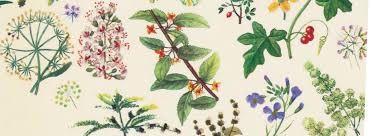
Adornment of Women's Faces
First of all, let her wash her face very well with French soap and with warm water and with a straining of bran let her wash herself in the bath. Afterwards oil of tartar take and, having first dried her face, let her anoint it.
Oil of Tartar is made thus:
To conclude, my Lady Elditha and her daughters would have had access to many of the more exotic ingredients mentioned above. There was extensive travel and trading during the early middle ages and ingredients came from very far flung lands, but that is a post for another time. I think I shall be happy to continue using my own modern day natural products and I am not so sure about any of the above!
The Handfasted Wife, a novel about Edith Swan-Neck, King Harold II's common-law wife is published by Accent Press and available on Amazon USA and UK as paperback and is also available for all e readers. And to celebrate the end of my first month in print a free apple download. Can whoever takes this code leave a message to say it is taken please.
TE9N4N74HLLE ( to redeem go to The Handfasted Wife on I tunes books and click on codes button there. This came as a promotion to my publisher Accent and they kindly gave me a few for reviews etc. Enjoy!)
| Herbs and spices, essential ingredients |
In this wonderful book there is a section entitled 'On Women's Cosmetics'. The suggestions here range from depilatory treatments to hair treatments and face adornment. There are also recorded treatments for whitening the teeth and for lip care.
Here are a few of my favourites, ideas which I have consulted for my second novel in a trilogy about The Women of Hastings that is scheduled to follow from Edith Swan-Neck's story in The Handfasted Wife.
Look at the bottom of this post for a free I tunes copy of this novel.
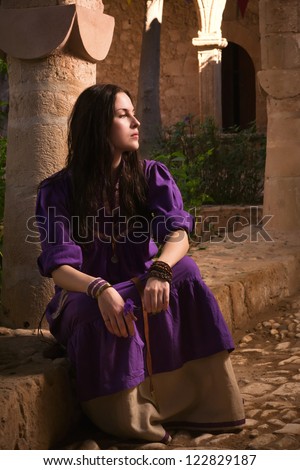 |
| medieval girl outside an Italian Monastery |
The Depilatory
Take quicklime and orpiment (a yellow sulphide mineral). Place these in a small linen sack and let them boil until they are cooked. If the depilatory be too thick, put fresh water in it to thin it. Take care it is not cooked too much and does not stay on the skin too long. It causes intense heat. And note that the dried powder of this is good for abrading bad flesh and for making hair grow again on the heads of people with tinea (ringworm infection). But first the affected place must be anointed with oil or honey. Then the powder is sprinkled on.
A Cure for Blemishes
Take the juice of squirting cucumber and almond milk; with these placed in a vessel, gently mix in quicklime and orpiment. Add powdered galbanum (a fragrant Persian gum resin) mixed with a small amount of wine for a day and a night, and cook with this. Once it is well-cooked you should remove the substance of the galbanum and put in a little oil. Having made the decoction, you should remove it from the fire and add a powder of herbs, mastic, frankincense, cinnamon, nutmeg and clove in equal amounts. This ointment smells sweetly and is gentle for softening the skin. A popular depilatory as well.
| The Castle Kitchen 12th/13thC |
Hair
If you wish to have hair soft and smooth and fine, wash it often with hot water in which there is powder of natron and vetch.
After leaving the bath, let her adorn her hair, and first of all let her wash it with a cleanser such as this:
Take ashes of burnt wine, chaff of barley nodes, and licorice wood ( so it may more brightly shine), and sow-bread; boil the chaff and sowbread in water. With the chaff and the sowbread, let a pot having at its base two or three small openings be filled. Let the water in which the sowbread and chaff were previously cooked be poured into the pot, so that it is strained by the small openings. With this cleanser let the woman wash her head. After washing , let her leave it to dry by itself, and her hair will be golden and shimmering.
If indeed you want to have thick, black hair, take colcynth and, having thrown away the insides, let it be filled with laurel to which have been added henbane seed and a bit of orpiment. And let the hair be anointed with this often.
Adornment of Women's Faces
First of all, let her wash her face very well with French soap and with warm water and with a straining of bran let her wash herself in the bath. Afterwards oil of tartar take and, having first dried her face, let her anoint it.
Oil of Tartar is made thus:
- break tartar into little bits
- wrap in piece of cloth and dip in strong vinegar and make it soaking wet
- place on fire until it turns to coals
- place in bowl and mix with oil using fingers
- expose to air for three nights
- collect the oil in a jug
- let the woman anoint herself with this oil for fifteen days at night
- in the morning wash with warm water and fatty residue of starch to soften it
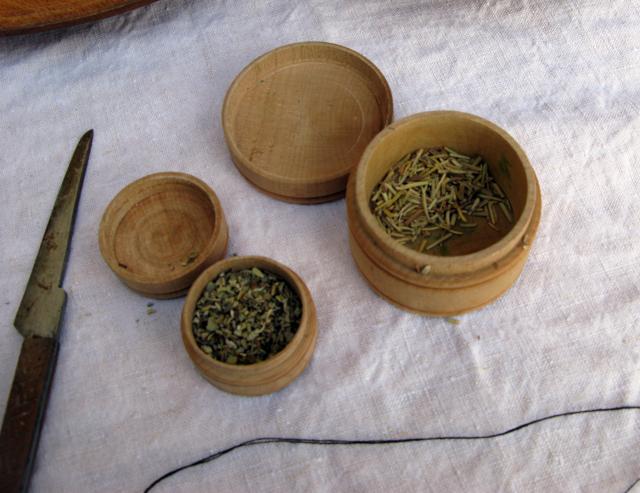 |
| Are we ready to try to compose treatments! |
To conclude, my Lady Elditha and her daughters would have had access to many of the more exotic ingredients mentioned above. There was extensive travel and trading during the early middle ages and ingredients came from very far flung lands, but that is a post for another time. I think I shall be happy to continue using my own modern day natural products and I am not so sure about any of the above!
The Handfasted Wife, a novel about Edith Swan-Neck, King Harold II's common-law wife is published by Accent Press and available on Amazon USA and UK as paperback and is also available for all e readers. And to celebrate the end of my first month in print a free apple download. Can whoever takes this code leave a message to say it is taken please.
TE9N4N74HLLE ( to redeem go to The Handfasted Wife on I tunes books and click on codes button there. This came as a promotion to my publisher Accent and they kindly gave me a few for reviews etc. Enjoy!)
.jpg)
